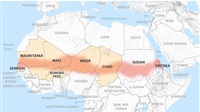Saudi Arabia announces Hajj protocols, measures for pilgrims

Saudi Arabia will enforce several health measures
and protocols for Muslims who will be performing the upcoming Hajj pilgrimage
in an effort to prevent the deadly coronavirus from spreading, the Kingdom’s
Minister of Health Dr. Tawfiq al-Rabiah said on Tuesday.
The Hajj pilgrimage, which is one of the five
pillars of Islam and a must for able-bodied Muslims at least once in their
lifetime, will only welcome a “limited number” of people this year, the
country’s foreign ministry had said on Monday.
Every year, about 2.5 million Muslims visit the
holiest sites of Islam in Mecca and Medina, which could make it a possible
breeding ground for the disease.
To prevent COVID-19 from spreading among pilgrims,
the health ministry, in collaboration with the Ministry of Hajj and Umraj,
developed a plan to ensure the safety of all visitors.
For all the latest headlines follow our Google News
channel online or via the app.
“We worked with the Ministry of Health in Saudi
Arabia to develop preventative and precautionary measures and protocols that
are needed to ensure a safe Hajj season,” the Minister of Hajj and Umrah
Muhammad Saleh Benten said.
Coronavirus: Saudi Arabia will lift COVID-19
restrictions on June 21
Here are the protocols:
1. No more than 10,000 people will be allowed to
perform the Hajj pilgrimage at a single time.
2. All pilgrims will be tested before they reach the
holy sites.
3. Only Muslims under the age of 65 will be allowed
to perform Hajj this year.
4. All pilgrims will be asked to self-quarantine
after they complete the Hajj rituals.
5. All workers and volunteers will be tested before
the Hajj pilgrimage begins.
6. The health status of all pilgrims will be
monitored daily.
7. A hospital has been prepared for any emergency
that occurs during the pilgrimage.
8. Social distancing measures will be enforced.
A total of 9,108,670 people worldwide have been
infected with the deadly coronavirus, which has also killed 472,703 others,
according to a tally by John Hopkins University.







